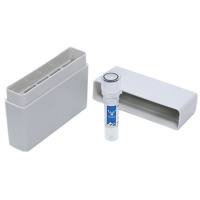ANTIBODY BINDING TO PROTEIN A AND PROTEIN G
互联网
- Table I
| Species | Protein A | Protein G |
|---|---|---|
| Human | <center><font>++++</font> </center> | <center><font>++++</font> </center> |
| Mouse | <center><font>++</font> </center> | <center><font>++</font> </center> |
| Rat | <center><font>+/-</font> </center> | <center><font>++</font> </center> |
| Hamster | <center><font>+</font> </center> | <center><font>++</font> </center> |
| Guinea Pig | <center><font>++++</font> </center> | <center><font>++</font> </center> |
| Rabbit | <center><font>++++</font> </center> | <center><font>+++</font> </center> |
| Horse | <center><font>++</font> </center> | <center><font>++++</font> </center> |
| Cow | <center><font>++</font> </center> | <center><font>++++</font> </center> |
| Pig | <center><font>+++</font> </center> | <center><font>+++</font> </center> |
| Sheep | <center><font>+/-</font> </center> | <center><font>++</font> </center> |
| Goat | <center><font>-</font> </center> | <center><font>++</font> </center> |
| Chicken | <center><font>-</font> </center> | <center><font>+</font> </center> |
- Table II
| Species | Protein A | Protein G |
|---|---|---|
| Human IgG1 | <center><font>++++</font> </center> | <center><font>++++</font> </center> |
| Human IgG2 | <center><font>++++</font> </center> | <center><font>++++</font> </center> |
| Human IgG3 | <center><font>-</font> </center> | <center><font>++++</font> </center> |
| Human IgG4 | <center><font>++++</font> </center> | <center><font>++++</font> </center> |
| Mouse IgG1 | <center><font>+</font> </center> | <center><font>++++</font> </center> |
| Mouse IgG2a | <center><font>++++</font> </center> | <center><font>++++</font> </center> |
| Mouse IgG2b | <center><font>+++</font> </center> | <center><font>+++</font> </center> |
| Mouse IgG3 | <center><font>++</font> </center> | <center><font>+++</font> </center> |
| Rat IgG1 | <center><font>-</font> </center> | <center><font>+</font> </center> |
| Rat IgG2a | <center><font>-</font> </center> | <center><font>++++</font> </center> |
| Rat IgG2b | <center><font>-</font> </center> | <center><font>++</font> </center> |
| Rat IgG2c | <center><font>+</font> </center> | <center><font>++</font> </center> |
Sources of information:
上一篇:Hybridoma Production 下一篇:Coupling Peptides To Resin For Affinity Purification









